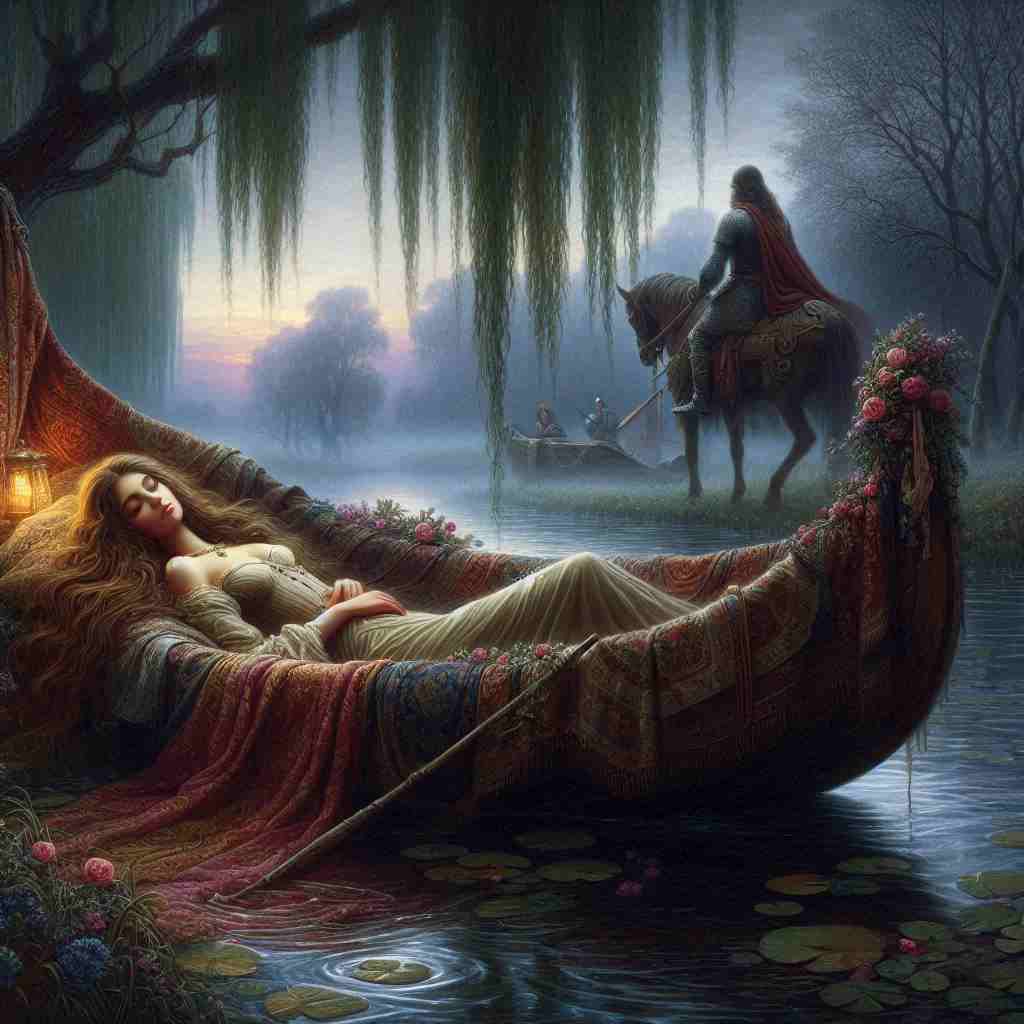The Lady of Shalott
Richard

By the river Camelot, a tower stands tall
Where the Lady of Shalott weaves within her hall
Cursed to never gaze upon the world outside
Her fate is sealed, her life denied
Weaving her tapestry, day by day
Cursed to never look upon the world
Trapped inside her tower, she must stay
Her gaze is fixed, her fate is unfurled
Oh the Lady of Shalott
Bound by a spell, her life forgot
Mirrored images, her only lot
Oh the Lady of Shalott
Sir Lancelot rides by, a dazzling sight
She glimpses him, her heart begins to race
Forsaking her loom, she steps into the light
And walks towards her doom, with sorrow on her face
The curse has taken hold, her world starts to fade
Down to the river, her boat is made
Drifting away, her song is played
In the river she lies, pale and still
Lancelot gazes on, his heart does not thrill
"She has a lovely face," he says with a will
Oh the Lady of Shalott
Richard's The Lady of Shalott
The Lady of Shalott, inspired by Alfred, Lord Tennyson's famous poem, weaves a haunting tale of isolation, longing, and tragic fate. This song delves deep into the psyche of a woman trapped not only by physical confines but also by societal expectations and the fear of engaging with the world.
The opening verses paint a vivid picture of the Lady's isolation. The tower, standing tall by the river Camelot, serves as both her sanctuary and her prison. The curse that binds her to this solitary existence is a powerful metaphor for the myriad ways in which individuals can become trapped in their own lives, whether by circumstances, fears, or self-imposed limitations.
The Lady's weaving becomes a poignant symbol of creativity born from isolation. Her tapestry, woven from mirrored images, represents the distorted view of reality that can arise when one is removed from direct experience. This aspect of the song invites reflection on how our perceptions of the world are shaped by our experiences - or lack thereof.
The repetition of the chorus "Oh the Lady of Shalott, bound by a spell, her life forgot" serves as a haunting reminder of the Lady's plight. It underscores the tragedy of a life unlived, of potential unfulfilled due to constraints both real and imagined.
The arrival of Sir Lancelot marks a pivotal moment in the narrative. His presence represents temptation, the allure of the outside world, and the promise of love and connection. The Lady's decision to look upon him directly, forsaking her loom and stepping into the light, is a powerful metaphor for taking risks and embracing life, even at great cost.
The consequences of her choice are swift and severe. The curse takes hold, and the Lady embarks on her final journey down the river. This sequence can be interpreted as a commentary on the price of freedom and self-realization. It poses the question: Is it better to live briefly but fully, or to exist indefinitely in a state of safe but unfulfilling isolation?
The song's ending, with Lancelot's somewhat callous observation of the Lady's lovely face, adds a layer of bitter irony. It highlights the disconnect between the profound internal experience of the Lady and the superficial perception of those around her. This moment invites listeners to consider how often we fail to recognize the depth of others' struggles and experiences.
Throughout the song, the interplay between fate and choice is a central theme. While the Lady is bound by a curse, it is ultimately her decision to break free that seals her fate. This nuanced treatment of destiny versus free will encourages listeners to contemplate their own agency in life and the consequences of their choices.
The Lady of Shalott is more than just a retelling of a classic tale. It's an exploration of the human condition, touching on themes of isolation, the yearning for connection, the conflict between safety and fulfillment, and the sometimes tragic consequences of pursuing one's desires. It challenges listeners to examine their own lives, to question the 'curses' that may be holding them back, and to consider whether the risk of engaging fully with the world is worth the potential cost.
This text was generated by AI and is for reference only. Learn more
Want to join the discussion? Reopen or create a unique username to comment. No personal details required!



Comments
No comments yet. Be the first to comment!